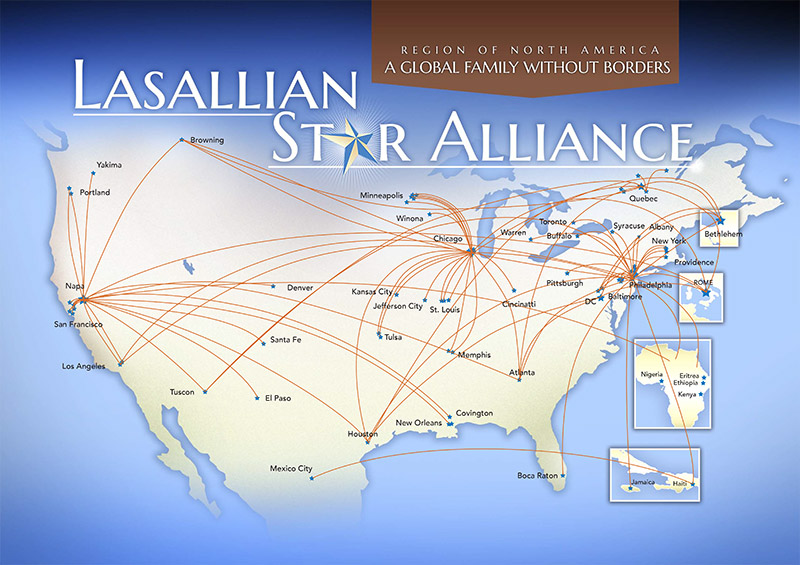Recently, while sitting in 22B on a United Airlines flight, I had a great awakening when the president of United came on the screen in front of me with a commercial.
He wore a shirt with the United emblem on the chest. Behind him stood a plane with the usual markings, but not once in his speech did he use the word “United.” He repeatedly referred to “we, the Star Alliance” and how “we” reach every corner of the world with the greatest safety and service record of all time.
A smile came over my face as I realized this once bankrupt airline was refounding itself by facilitating an alliance of initially five airlines and now 28 carriers. Alliance members count each others cities and fill each others planes while keeping customers faithful to themselves — a very smart way for each to reinvent themselves.
And then it hit me like a bolt. My whole life has been spent in the Lasallian Star Alliance: the one formed over 200 years before United was ever heard of; the one that today reaches every corner of the world with human and Christian education; the one that has doubled in breadth and depth since I was born in 1940; the one with a thousand locations across the world; and the one with 80,000 Lasallian women and men serving a million students and adults every day of the year.
Historically, the star was a favorite of De La Salle who linked it to the spirit of his new institute — and his followers have continued this priority ever since. The star is so ingrained in the soul of this Lasallian family that virtually every Lasallian entity includes the image on their website and every international Lasallian group adopts some form of it in their logo: young Lasallians, college professors, formators, Brothers, researchers, and partners and Brothers together.
We Are the Star Alliance
Similar to United and its partners, the Lasallian alliance moves people across the world. But it also does so much more. It links, enables and energizes them to associate together to enhance the lives of a million young people and their families (the Lasallian mission) on the local, regional and global levels.
The five pointed star symbolizes our core values: respect for all persons; quality education; faith in the presence of God; inclusive community; and concern for the poor and social justice. Similarly, the alliance is broken into five regions of the world: Africa, Asia and Oceania, Latin America, Europe and the Mediterranean, and our North America. Like United, within each region there are hubs (called districts) the locus of activities of local Lasallians.
See the map of the Lasallian Star Alliance and it’s various hubs that connect Lasallian cities within the Region of North America. The essence of this alliance is the thousands of connections forged between large numbers of Lasallians on an international level, as well as across and within hubs and regions. They share best practice, learn new insights, and grow in commitment to the Lasallian mission. There is a passion, a charism, a fire in the heart and a charm that pervades this incredible worldwide family every time it gathers. It’s the Spirit of God within, among, and over all of us.
In my corner of the world, the Eastern North American hub called DENA, almost 5,000 Lasallians at 40 locations serve almost 28,000 students and families. Beyond alliance activities involving each of these Lasallians at their site, at least 645 are actively involved in local hub activities each year in events, programs and workshops within the hub area. Enlarge these numbers with similar activities generated in the other three hubs of the North American region and you have an enormous connectivity of people captured by the lines on the map.
On the regional level, another 575 Lasallians drawn from all North American hubs gather annually with each other for institutes, workshops, conferences and symposiums located in cities across the region.
On a global level, at least 130 other Lasallians from the Region of North America join annually with hundreds from the other four regions of the world to participate in global activities (mostly held in Rome). And this number reaches into untold thousands when factoring in the efforts of students across the region involved in Twinning activities with students in the Lwanga hub of East Africa. In describing this amazing Lenten 2014 effort, the regional website for the alliance reads: “Twinning is not simply about providing funds to Lasallians in Africa. It’s also about creating partnerships that bring together Lasallian students on two continents, in solidarity as brothers and sisters, to share challenges, accomplishments, stories, and experiences.”
The alliance lives.
In every location, the alliance happens on these levels:
Communication
The most basic alliance is between participant institutions and individual Lasallians who communicate with one another. They let each other know what services they have and who they serve. Each is totally independent.
Cooperation
Some move to the level of cooperation with each other. Alliance members might change the time or schedule of school to enable parents to take advantage of services at multiple locations. Each has to sacrifice some of their total independence.
Collaboration
In this more advanced alliance, members actually cooperate so much that new, more creative services come out of their efforts (ie. Lasallians from many hubs and regions have come together to assist Haitians in the aftermath of the earthquake).
Brother Edward Phelan is Auxiliary Provincial in the DENA hub of the Lasallian Star Alliance.



Ed you are amazing and always inspiting! Always been in yout Lasallian “camp” wven when others were not!